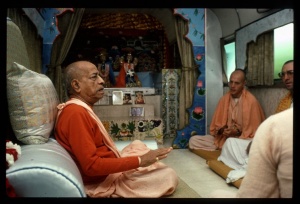SB 5.3.3

A.C. Bhaktivedanta Swami Prabhupada
TEXT 3
- atha ha tam āviṣkṛta-bhuja-yugala-dvayaṁ hiraṇmayaṁ
- puruṣa-viśeṣaṁ kapiśa-kauśeyāmbara-dharam
- urasi vilasac-chrīvatsa-lalāmaṁ daravara-vanaruha-vana-
- mālācchūry-amṛta-maṇi-gadādibhir upalakṣitaṁ
- sphuṭa-kiraṇa-pravara-mukuṭa-kuṇḍala-kaṭaka-kaṭi-sūtra-hāra-
- keyūra-nūpurādy-aṅga-bhūṣaṇa-vibhūṣitam
- ṛtvik-sadasya-gṛha-patayo 'dhanā ivottama-dhanam
- upalabhya sabahu-mānam arhaṇenāvanata-śīrṣāṇa upatasthuḥ
SYNONYMS
atha — thereafter; ha — certainly; tam — Him; āviṣkṛta-bhuja-yugala-dvayam — who manifested Himself with four arms; hiraṇmayam — very bright; puruṣa-viśeṣam — the topmost of all living beings, Puruṣottama; kapiśa-kauśeya-ambara-dharam — wearing a yellow silk garment; urasi — on the chest; vilasat — beautiful; śrīvatsa — called Śrīvatsa; lalāmam — possessing the mark; dara-vara — by a conchshell; vana-ruha — lotus flower; vana-mālā — garland of forest flowers; acchūri — disc; amṛta-maṇi — the Kaustubha gem; gadā-ādibhiḥ — and by a club and other symbols; upalakṣitam — symptomized; sphuṭa-kiraṇa — radiant; pravara — excellent; mukuṭa — helmet; kuṇḍala — earrings; kaṭaka — bracelets; kaṭi-sūtra — girdle; hāra — necklace; keyūra — armlets; nūpura — ankle bells; ādi — and so on; aṅga — of the body; bhūṣaṇa — with ornaments; vibhūṣitam — decorated; ṛtvik — the priests; sadasya — associates; gṛha-patayaḥ — and King Nābhi; adhanāḥ — poor persons; iva — like; uttama-dhanam — a great treasure; upalabhya — having achieved; sa-bahu-mānam — with great regard; arhaṇena — with ingredients for worship; avanata — bent; śīrṣāṇaḥ — their heads; upatasthuḥ — worshiped.
TRANSLATION
Lord Viṣṇu appeared before King Nābhi with four arms. He was very bright, and He appeared to be the best of all personalities. Around the lower portion of His body, He wore a yellow silken garment. On His chest was the mark of Śrīvatsa, which always displays beauty. He carried a conchshell, lotus flower, disc and club, and He wore a garland of forest flowers and the Kaustubha gem. He was beautifully decorated with a helmet, earrings, bangles, belt, pearl necklace, armlets, ankle bells and other bodily ornaments bedecked with radiant jewels. Seeing the Lord present before them, King Nābhi and his priests and associates felt just like poor people who have suddenly attained great riches. They received the Lord and respectfully bent their heads and offered Him things in worship.
PURPORT
It is distinctly mentioned here that the Supreme Personality of Godhead did not appear as an ordinary human being. He appeared before King Nābhi and his associates as the best of all personalities (Puruṣottama). As stated in the Vedas: Nityo nityānāṁ cetanaś cetanānām (Kaṭha Upaniṣad 2.2.13). The Supreme Personality of Godhead is also a living being, but He is the supreme living being. In Bhagavad-gītā (BG 7.7), Lord Kṛṣṇa Himself says. mattaḥ parataraṁ nānyat kiñcid asti dhanañjaya: "O conqueror of wealth [Arjuna], there is no truth superior to Me." No one is more attractive or more authoritative than Lord Kṛṣṇa. That is one of the differences between God and an ordinary living being. According to this description of the transcendental body of Lord Viṣṇu, the Lord can easily be distinguished from all other living beings. Consequently Mahārāja Nābhi and his priests and associates all offered the Lord obeisances and began to worship Him with various things. As stated in Bhagavad-gītā (BG 6.22), yaṁ labdhvā cāparaṁ lābhaṁ manyate nādhikaṁ tataḥ. That is, "Upon gaining this, one thinks that there is no greater gain." When one realizes God and sees the Lord face to face, one certainly thinks that he has gained the best of all things. Raso 'py asya paraṁ dṛṣṭvā nivartate: (BG 2.59) when one experiences a higher taste, his consciousness is fixed. After seeing the Supreme Personality of Godhead, one ceases to be attracted by anything material. One then remains steady in his worship of the Supreme Personality of Godhead.